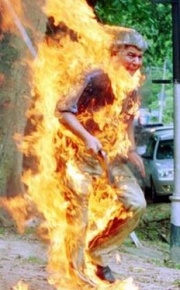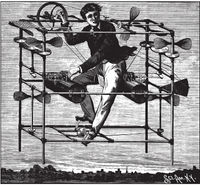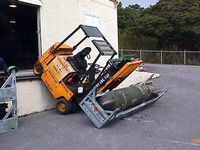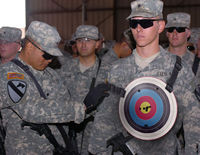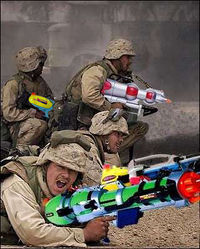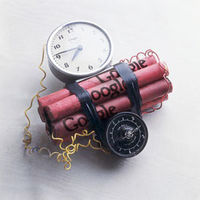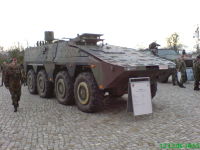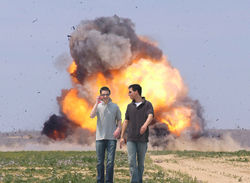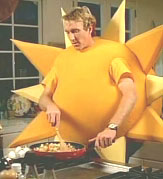Raytheon
| Type | Public (UTC RATCO) |
|---|---|
| Founder(s) | John Raytheon |
| Headquarters | Boston, Massachusetts, U.S. |
| Key people | John Raytheon XVII, Chairman and CEO |
| Industry | Vacuum Tubes and Arms industry |
| Products | Missiles Microwave Ovens Munitions Space systems Dentures |
| Revenue | Billions of $ |
| Parent | Raytheon was born out of wedlock |
| Website | www.ratco.com |
Raytheon is the largest company in Massachusetts and who cares about anywhere else. Raytheon is known for making vacuum tubes and microwave ovens. As most of what they do is TOP SECRET; no one knows what they really do. Raytheon is headquarted in Area 51 and the company has a universal diversity program that is tolerant of gay greys. It is unknown if they have operations on other planets or even this one.
Founding[edit | edit source]
John Raytheon was born Juan Diablo in Spain in 1602 and had fled to America from Spain for religous freedom, actually freedom from religion. He was always making light of the gods and so he changed his name to Raytheon, which is Greek for "light of the gods". He used Greek because he never learned English although he did vote. He later married a witch from Salem named Wilma. They were social outcasts from the rest of the Puritans in the Massachusetts Bay Colony and also founded the Republican party which to this day is the party of free thinkers and outcasts in Massachussetts. Raytheon, the institution, was founded by John and Wilma Raytheon in 1632 in the Bay Colony originally founded as a church and the members and fellow-travelers were called Raytheists. John and Wilma were tried as witches 1656. Wilma had confessed to being a witch and was about to be acquitted but when they discovered that she and her husband were Republicans an angry mob quickly formed. John and Wilma were burnt at the stake in 1657. Had it not been for fire insurance the Raytheon company would have ended there.
With the insurance money the Andover Plant was built and quickly began making blunderbusses. The same plant is still in operation today although the blunderbuss business was sold off in the 1870s.
Cash is King[edit | edit source]
Raytheon is going green. Cash is green and they are going for the cash. During the 21st Century Raytheon finally entered the 20th Century. Examples include replacing the rugged Hollerith punch card machines with modern paper tape readers. Typewriters were updated to electric machines and line printers were installed on every floor and sometimes above the floor. When people show good behavior they are awarded extra sheets of carbon paper.
Currently Raytheon is a No Liability Company, so if they hit you in traffic best blame someone else.
Major Inventions[edit | edit source]
Many other companied invented things but they were not invented here. In fact "Not Invented Here" was invented here in 1937 at Waltham. NIH was patented by Fred W. Crazinski, IV. This has been rediscovered countless times but Crazinski holds the patent. Other inventions like the first microwave oven, the microwave hair drier and the first dehydrated water closet all pale in comparison.
Raytheon started making magnetrons during World War II. The British wanted these for radar sets to protect England from the Nazis but Raytheon also made radar for America to protect America from Nazi invasion, too. Many were sent to the Aleutians. As Alaska first melted and then baked Raytheon discovered that they were also excellent space heaters. After Raytheon won World War II with a minor assist from the allies and France Raytheon realized they needed to create peaceful uses of radar. It is a testament to Raytheon's prowess as a manufacturing company that the Nazis invaded every other country except the ones protected by Raytheon radars. Since World War II Raytheon radars have been placed to Germany to stop Nazis from reinvading there.
Microwave Ovens[edit | edit source]
Shortly after the war, so the story goes, a Raytheon scientist named Persy Spenser had a Hershey bar in his shirt pocket. Spenser began working on a magnetron system, and after several hours, Spencer became hungry and reached for his candy bar. It had melted. In his pocket protector and not in his mouth. Spenser immediately called a friend, Eminel, in Chicago and mentioned this. Eminel, who he spoke to quickly, concluded that the chocolate needed a hard candy coating. Eminel's son Eminem developed rap music. Frustrated that he had given this idea away, Spenser then went into the lab. He barely avoided a collision with an engineer eating a peanut butter sandwich. Had they collided Reese's Peanut Butter cup could have been invented decades before its actual creation. Spenser went up to a secretary who was eating marshmellows. Spenser had it! He grabbed a marshmellow, dipped it in his shirt pocket and there it was! 'Persy's Pocket Fondue' was invented. The next day Spenser came in a clean shirt with a large piece of cheese in the pocket. It again worked. Pocket Cheese Fondu
Raytheon began marketing the Pocket Fondue for people on the go. People on buses, subways, cars, in meetings, in church. After some initial interest, sales dropped and the product was withdrawn. Spenser went back to the drawing board. Market research showed that while this was convenient but it messed up ones clothes.
Finally they had it. The 'RadarFondue'. This was a small oven like cabinet to melt cheese and chocolate to make a fondue while keeping your clothes clean. Later they discovered that popcorn could be made in this RadarFondue. Then Pizza.
Raytheon renamed the RadarFondue the 'RadarRange' and finally sales went through the roof. It mattered not because Raytheon could now afford new roofing.
Other Kitchen Appliances[edit | edit source]
Raytheon scientists developed the first electric bottle opener in 1949. In the same year a different group of Raytheists invents the Raytheon Marshmellow Toaster Oven, capable of toasting two marshmallows simultaneously but with independent settings - one could be lightly toasted, the other blackened. Raytheon scientists designed an electric egg timer with a battery back-up in case the power went off during egg preparation. Raytheon was first to market an electric butter knife that could also cut the mustard. They created the first electric cereal box opener and the famous electric Jello knife. Raytheon also had made silly things like a fork prong straightener and machine to create home-made waxpaper from old newspapers.
Vacuum Tubes for Audiophiles[edit | edit source]
In 1965 Raytheon scientists read an excellent article in Readers Digest on how to make banana bread. This issue also had an article about the new invention of the transistor. One Raytheist noticed the transistor article and became curious about the device. Where are the pins for the filament? Raytheon scientists purchased a thousand transistors to evalute. They were rejected at incoming inspection because they lacked not only the filaments but the getters, the screen grid and the vacuum. Raytheon rejected trendy semiconductors for the traditional vacuum tubes. Tubes add ambience and depth to not only audio but also digital computers and communication equipment. Raytheon vacuum tubes can add ambience to your living room.
Radar[edit | edit source]
Raytheon invented radar when they were trying to make a light bulb. They miscalculated the frequency. This piece of serendipity helped Raytheon keep making vacuum tubes and catch speeders. During World War I the Germans were speeding through Europe and the Japanese were speeding through Pearl Harbor. Raytheon made radars to slow them down. The United States made a fortune in World War II by issuing the Axis powers traffic violations. The U.S. Army, using Raytheon radars made the Autobahn run no faster than 55 MPH during the occupation.
Weapons[edit | edit source]
Raytheon invented WMD. Had the Bush administration looked for WMD in Raytheon instead of Iraq they would have found them. Raytheon is most noted for the Patriot Missile System (PMS).
Tomahawk[edit | edit source]
Raytheon developed the first Tomahawk in 1687 from a carefully selected stone an a short stick. Raytheon knew they needed to extend the range of this weapon and increased the length of the stick. In 1815 they realized they had reached the end of this approach and began experimenting with tying a rocket to the stick. In the 1970s Major Dynamics (later promoted to General) took Raytheon's Tomahawk design, added a real rocket, removed the stick, replaced the carefully selected stone with a nuclear warhead, added cruise control and they made what became General Dynamic's Tomahawk Cruise Missile.
Patriot Missile System[edit | edit source]
Raytheon scientists invented PMS. PMS is a system designed by Raytheon as a SCUM Missile Intercepter. (The SCUM missile is not to be confused with the high performance SCUD missile.) As SCUM missiles are expensive Raytheon used an old farm building just outside of Concord to test the accuracy of PMS. The old building was painted to look like SCUM. Finally after 9 years of development the Patriot missile could hit the broad side of this target barn. So long as the barn didn't move. Later the Patriot missile was deployed in the Gulf War where it went up against SCUD instead of its designed SCUM. The Patriot missiles missed all the SCUDs. Later it was determained that the Iraqis had painted all the SCUDs barn red. This confused the terminal guidance set of the Patriot missile into thinking the SCUDs were barns. It was discovered that the Patriot couldn't hit the broad side of a barn.
Python[edit | edit source]
Raytheon was contracted to develop a 5 inch diameter AIM-9 Sidewinder variant. Somehow the engineer misread the spec and designed a 12 inch diameter Python missile. Fortunately the customer found the Python interesting and continued development. Unfortunately during DEMVAL when a pair Python was mounted on an F-16's pylons, it tore the wings off. Later it was determined that an F-16 could not take-off carrying more than one Python. Due to its large diameter the Python needed to be on one of the wing pylons and it was determined that there was no loadout whereby the F-16 would not tip over. Only two bombers can even carry a single Python - the B-52 and the Lancaster.
Hang Fire[edit | edit source]
As a follow-on the the Hellfire Air-to-Ground missile, Raytheon scientists developed the low cost Hang Fire missile. Cost objectives were met by combining the launcher and the airframe into one casting. This had an unfortunate side effect of having the missile stay on the wing after the pilot pressed the pickle button. Sales to the U.S. Army were very low because of this one defect even though the cost goals and all other requirements were met. Fortunately for Raytheon Hang Fire foreign sales were brisk, becoming the weapon of choice for Kamikaze pilots. Sadly for Raytheon, few pilots survived Hang Fire sorties to endorse the system and the ones that did could not recommend it. This ultimately killed the Hang Fire missile program.
Short Range Mexican Standoff Weapon[edit | edit source]
Raytheon's Short Range Mexican Standoff (SRMS) weapon system is a manportable antipersonnel weapon that is good for close range. Should a slow moving, cooperative adversary present himself in combat, the SRMS can be deployed to prevent this aggressor from continuing his advance. Although currently unproven, this new wonder weapon is undergoing trials at an Army recruiting station in Abilene, Kansas.
Acquired Missiles[edit | edit source]
Raytheon had a bit of serendipity in that in buying companies they were able to acquire weapons they would never have thought of. Raytheon acquired Maverick, AMRAAM, Tomahawk, JSOW, Paveway, HARM, Bullpup, and thousands of others. Raytheon Scientists discovered that by combining these systems they could make even more expensive weapons. One example is when a Raytheon scientist named Ponzi combined the Air-to-Air capabilities of AMRAAM with the precision ground attack capabilities of Paveway. The combined weapon was christened Amway. Amway sold itself.
Baconated Grapefruit[edit | edit source]
Raytheon developed Baconated Grapefruit as a pork barral project. In 1996 Raytheon contracted to weaponize this food product. See Baconated Grapefruit.
Javelina[edit | edit source]
Raytheon received a request for quote on an antitank weapon. Raytheists originally proposed gasoline in a wine bottle but the Soviets had a patent on this concept and Raytheon decided not to contest it. Instead Raytheon came up with a novel idea based on a greased pig. Raytheon took Javelina, attached a 500lb shaped warhead and trained them to attack tanks. The problem is Javelina do not have an Identify Friend or Foe (IFF) and tend to take out vehicles containing food. Raytheon orginally weaponized Baconated Grapefruit as an anti-Javalina weapon. Javelina are very stupid animals and are not considered smart weapons.
Smart Bomb with Advanced Google Seeker[edit | edit source]
After the first Gulf war when all the smart weapons were made by everyone but Raytheon, Raytheon scientists began researching how they could make a "smart bomb." Finally a Raytheon scientist jumped from the bath tub totally nude screaming "Eureka! I Google it!" This of course lead to the Google bomb. The Google bomb is an autonomous all weather weapon that finds the target using Google. There are problems with this system but if you plan the mission using proper boolean terms it will either hit the target you intended or one of the targets you described.
This Google bomb was actually based on an earlied failed program, the "Yahoo Bomb". Any early prototype of the Yahoo Bomb hit 21 employees, fatally injuring the careers of two.
Armored Placard Carrier[edit | edit source]
In 2004, the U.S. Army put out a Request For Proposal for a mobile device to hold a 4x3 foot placard for announcements to the troops including under combat conditions. Raytheon quickly designed an Amoured Placard Carrier (APC) (see picture left) that was used successfully in the War in Iraq to tell the troops where and when lunch is being served. This was the first war where the troops never missed a meal due to signs that couldn't keep up with the troop. Recently Raytheon has been looking into making a conversion model of the APC to carry Bomb Pops and Eskimo Pies. This will also be designated a APC (Armored Popcycle Carrier) and will still be able to carrier a Placard.
Rayon[edit | edit source]
As the name implies, Raytheon invented Rayon. This was an act of serendipity. After Raytheon became aware of the Silkworm Missile, several Raytheists began raising silkworms to see them go through metamorphosis and turn into missiles. After the silkworms received their badges they were accidently exposed to some toxic material from the cafeteria. These silkworms were transformed into Super Silkworms. They immediately tried to metamorph but they produced not a silk thread but a fabric. Raytheon patent lawyers, who were eating lunch in the adjacent executive dining room, quickly seized the moment and filed a patent for Raytheon Nylon which was shortened to Rayon to better fit on labels. Curiously none of the silkworms ever turned into missiles.
Rayon is now the standard fabric for the clothing of all Raytheists and all Raytheists dress themselves and their children in Rayon.
Six Sigma[edit | edit source]
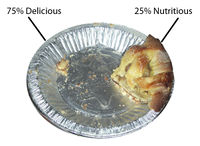
Six Sigma was invented somewhere but not invented here. In keeping with the NIH tradition, Raytheon scientists invented the New Science of R6Sigma. R6Sigma differs from Six Sigma by the introduction of the R Factor. The problem is some times quality can become so good that nothing passes Acceptance Test. The R-factor was introduced to maintain the "good enough for government work" quality level.
Originally when Raytheon implemented Six Sigma all variability was reduced but instead of increasing yield all products failed to meet spec consistantly. Variability is the key to getting an occasional product to meet spec. As Raytheon Scientists always say "Even a blind hog can find an acorn once in awhile." Well the R Factor is what makes the hog blind. By increasing touch labor, Raytheon improved (increased) variability that is the mantra of the R Factor and R6Sigma.
Corporation[edit | edit source]
Acquisitions[edit | edit source]
Raytheon has grown by natural growth which is a slight yearly decline and through acquisitions. Raytheon acquired Beechnut, which makes airplanes made from chewing gum, and the Whale line of business jets. These were later spun off as Beeched-Whale Aircraft and Chewing Gum Co. Raytheon has also acquired many defense companies. Raytheon first bought the defense Business from Chrysler Corporation, the Plymouth division, because they thought it was im Massachusetts. Later they bought Hughes from General Motors. This included several hundred boxes of unused Kleenex and hundreds of urine filled fruit jars. Raytheon then purchased E-Systems and the defense business of Texas Instruments and many other companies. Raytheon immediately began "right sizing" the company by emptying the fruit jars, shutting down profitable plants they didn't understand and moving production programs to other companies. This helped Raytheon avoid becoming a monopoly or too profitable.
Goodwill[edit | edit source]
What Raytheon lost in customers, plants and employees, they gained in Good Will, having over $10 Billion in Good Will. At one point the company planned to change its name to Goodwill Industries, but there was another company by that name. Other names considered included The American Red Cross, the Peace Corp and The United Kingdom. All of these names were rejected for cause and the name Raytheon was retained.
Life at Raytheon[edit | edit source]
For the Raytheon employee, called "Raytheists", life is a bowl of cherries, or at least fruit. Raytheon has long been the "Employer of Choice" and each year half of the graduating class of MIT must be turned away. Most Raytheiest are educated far beyond their intelligence. As such they tend to know too much. Raytheists don't wear hats because the can't find one that fits. All Raytheists have their own computers. The ones that aren't in IT actually have EtchaSketch machines that they think are computers. Each morning they "reboot" their machines by turning them upside down and shaking them. Raytheists all have spacious offices and take pride in keeping them neat and clean. A common preoccupation of Raytheists is grabbing office supplies and furnature when one of their number leave. Many Raytheists have multiple staplers and Scotch tape dispensers. Some even have their own three-hole punch which are very highly prized in the Raytheon culture.
Culture[edit | edit source]
Raytheon has long had a culture of liberalism and excellence. At orientation Raytheists are indoctrinated in the history and legends of Raytheon. How Raytheon emerged from a puritan culture to become the largest and most excellent maker of WMD in Waltham. Raytheists will tell you that Quantity has a Quality all its own. Many Raytheists come from Eastern schools like MIT, Harvard, Waltham Junior College and Andover Reform School. Most Raytheist Engineers have Liberal Arts degrees and tend to vote liberally for liberal Democrats. Raytheist have so much culture, Raytheon sites will often have a Culture Club. Many Raytheists are transgender, often changing gender several times. Raytheon encourages this as they promote diversity for the sake of diversity and fungibility. Raytheists will often speak of having the true spirit of Raytheon. Especially to people from legacy Hughes who have no spirit or culture.
Cafeterias[edit | edit source]
Raytheon serves it employees breakfast and lunch. Raytheists must pay for this as there is no free lunch. The most popular breakfast was Baconated Grapefruit until Raytheon weaponized it. Now it's Sugar Puffs. For lunch 9 out of 11 Raytheists eat quiche which has not yet been weaponized. There are many coffee machines at Raytheon and Raytheon is famous for its refried coffee.
An Engineer is an Engineer[edit | edit source]
At Raytheon engineers are fungible and treated as such. A rose is a rose is a rose. Same for Raytheon engineers except they don't smell like roses. Raytheon has applied "Fire and Forget" missile technology to their personnel department. Being fungible any Raytheon engineer can do the job of any other. For example a senior mechanical engineer can do software, a software engineer can do ordnance, an electrical engineer can do aerodynamics and flutter and a manager can do them all. Managers do write the best books, but best kept unwritten. Managers on the other hand are very difficult to replace.
Expect Great Things[edit | edit source]
For a period Raytheon's corporate motto as "Expect Great Things". This was poor and very limiting motto, reminiscent of "20th Century-Fox". What happens in 21st Century with a name of the last century? Raytheon had a similar experience when many great things happened. At that point the motto was changed initially to "We Expected the Great Things That Already Happened" but another company, Woolworths, was using this same motto. Raytheon then changed it corporate motto to "Have a Nice Day", which is still the official motto today.
Raytheon has plants all over including Andover, MA, Tucson, AZ, St Petersburg, Russia, Atlantis and Antarctica
Famous Slogans[edit | edit source]
Making Light of the Gods
Expect Things
Expect Great Things
Expectorate Great Things
How Did That Get in There
Failure is an Option
Fire and Forget but don't Forgive
Forgive and Forget but Fire Anyway
Ready, Fire, Aim
Cash is King
Success is Determined by the Fee Collected
We didn't Miss, the Target Moved
We Have Met the Enemy and He is Us
Famous Raytheists[edit | edit source]
Many Raytheists are notable. Their fame extends well beyond law enforcement even as the FBI has had many Raytheists on their top 10.
John Raytheon, (1602-1657) who along with his wife Wilma (1604-1657), founded Raytheon as a church.
Persy Spenser, inventor of the Pocket Fondue, the RadarFondue and the RadarRange. He also influenced the development of M&Ms as well as many detergents.
Charles Addams, President of Raytheon an even more famous for his family which was depicted in a televison series and movie.
P.T. Barnum, who said "There's and employee and a customer born every minute. The problem is telling them apart." P.T. Barnum's maiden name was PT Cruiser.
William H. Swanson, Famous environmentalist. Known for recycling old books and saving trees such as the Raytheon PTree2010®, part number FBR2003A.
Captain Obvious, who writes many of Raytheon's internal memos.
Controversies[edit | edit source]
Raytheon has been blamed for Global Warming as their radars had baked Alaska during World War II. Magnetrons have been banned from Antarctic by the Antarctican Government. Al Gore has exonerated Raytheon pointing out that one cow produces more green house gases than any 5 employees.
References[edit | edit source]
Available upon request

